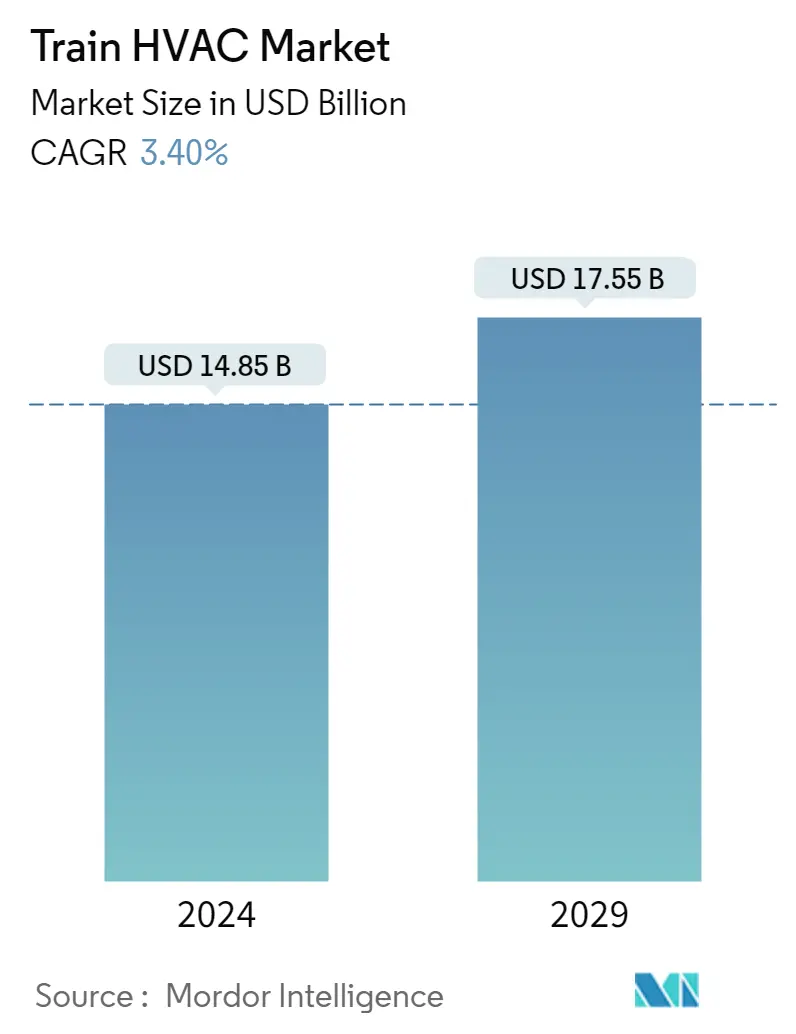Market Size of Train HVAC Industry

| Study Period | 2019 - 2029 |
| Market Size (2024) | USD 14.85 Billion |
| Market Size (2029) | USD 17.55 Billion |
| CAGR (2024 - 2029) | 3.40 % |
| Fastest Growing Market | Asia Pacific |
| Largest Market | Asia Pacific |
| Market Concentration | High |
Major Players
*Disclaimer: Major Players sorted in no particular order |
Train HVAC Market Analysis
The Train HVAC Market size is estimated at USD 14.85 billion in 2024, and is expected to reach USD 17.55 billion by 2029, growing at a CAGR of 3.40% during the forecast period (2024-2029).
During the outbreak of the COVID-19 pandemic, the work for the expansion of rail networks was halted because of the imposed lockdown and social distancing norms to control the spread of the virus. Yet, with the gradual opening of economies, the rail expansion work has resumed, and the governments are expected to invest more money for the development of these activities and bring the economy back on track. This trend is expected to follow during the forecast period as well.
As the world's population grows, so does the need for quicker, safer, and more pleasant transportation. As a result, governments throughout the world are spending extensively on railway infrastructure development, which is propelling the industry forward.
The train HVAC market is majorly driven by the increasing demand for HVAC systems from railways over the forecast period. In addition, the increase in demand for public transport by the government is also expected to boost the growth of the railway HVAC market. Additionally, the rising demand for comfort during traveling plays a significant role in fueling the growth of the railway HVAC market throughout the forecast period.
Train HVAC Industry Segmentation
The train HVAC market is segmented by train type, systems, refrigerants, components, and geography.
By train type, the market is segmented into passenger and freight.
By systems, the market is segmented into vapor cycle systems and air cycle systems.
Based on refrigerants, the market is segmented into conventional refrigerants and natural refrigerants (carbon dioxide (CO2)).
By components, the market is segmented into air dampers, blowers, compressors, condensers, evaporators, inverters, and other components.
By geography, the market is segmented into North America, Europe, Asia-Pacific, and Rest of the World.
| Train Type | |
| Passenger Train | |
| Freight Train |
| Systems | |
| Vapour Cycle Systems | |
| Air Cycle Systems |
| Refreigerants | |
| Coventional Refrigerants | |
| Natural Refrigerants (Carbon Dioxide (CO2)) |
| Components | |
| Air Dampers | |
| Blower | |
| Compressor | |
| Condenser | |
| Inverter | |
| Evaporator | |
| Other Components |
| Geography | ||||||||
| ||||||||
| ||||||||
| ||||||||
|
Train HVAC Market Size Summary
The train HVAC market is poised for steady growth over the forecast period, driven by increasing global demand for efficient and comfortable transportation solutions. As urban populations expand, governments worldwide are investing heavily in railway infrastructure to enhance public transport systems. This investment is fueled by the need for faster, safer, and more comfortable travel options, which in turn boosts the demand for HVAC systems in trains. The market is experiencing a resurgence following the disruptions caused by the COVID-19 pandemic, with rail expansion projects resuming and governments prioritizing infrastructure development to stimulate economic recovery. The focus on developing high-speed trains and integrating rapid transit systems with other public transport modes is a key trend, particularly in regions like Asia-Pacific, where countries such as China and India are leading the charge.
The Asia-Pacific region dominates the train HVAC market, supported by significant advancements in railway infrastructure and urban transit systems. China, with its extensive rapid transit networks, and India, with its ambitious modernization projects, are central to this growth. The market is characterized by the presence of major global players like Trane Technologies, Mitsubishi Electric, and Siemens AG, who are actively engaging in collaborations to innovate and enhance HVAC solutions. These companies are focusing on developing environmentally friendly technologies, such as alternative refrigerants, to meet evolving regulatory standards and consumer preferences. The ongoing expansion of railway networks, coupled with technological advancements and strategic partnerships, is expected to sustain the market's growth trajectory in the coming years.
Train HVAC Market Size - Table of Contents
-
1. MARKET DYNAMICS
-
1.1 Market Drivers
-
1.2 Market Restraints
-
1.3 Porter's Five Forces Analysis
-
1.3.1 Threat of New Entrants
-
1.3.2 Bargaining Power of Buyers/Consumers
-
1.3.3 Bargaining Power of Suppliers
-
1.3.4 Threat of Substitute Products
-
1.3.5 Intensity of Competitive Rivalry
-
-
-
2. MARKET SEGMENTATION
-
2.1 Train Type
-
2.1.1 Passenger Train
-
2.1.2 Freight Train
-
-
2.2 Systems
-
2.2.1 Vapour Cycle Systems
-
2.2.2 Air Cycle Systems
-
-
2.3 Refreigerants
-
2.3.1 Coventional Refrigerants
-
2.3.2 Natural Refrigerants (Carbon Dioxide (CO2))
-
-
2.4 Components
-
2.4.1 Air Dampers
-
2.4.2 Blower
-
2.4.3 Compressor
-
2.4.4 Condenser
-
2.4.5 Inverter
-
2.4.6 Evaporator
-
2.4.7 Other Components
-
-
2.5 Geography
-
2.5.1 North America
-
2.5.1.1 United States
-
2.5.1.2 Canada
-
2.5.1.3 Rest of North America
-
-
2.5.2 Europe
-
2.5.2.1 Germany
-
2.5.2.2 United Kingdom
-
2.5.2.3 France
-
2.5.2.4 Russia
-
2.5.2.5 Spain
-
2.5.2.6 Rest of Europe
-
-
2.5.3 Asia-Pacific
-
2.5.3.1 India
-
2.5.3.2 China
-
2.5.3.3 Japan
-
2.5.3.4 Rest of Asia-Pacific
-
-
2.5.4 Rest of the World
-
2.5.4.1 Brazil
-
2.5.4.2 United Arab Emirates
-
2.5.4.3 Other Countries
-
-
-
Train HVAC Market Size FAQs
How big is the Train HVAC Market?
The Train HVAC Market size is expected to reach USD 14.85 billion in 2024 and grow at a CAGR of 3.40% to reach USD 17.55 billion by 2029.
What is the current Train HVAC Market size?
In 2024, the Train HVAC Market size is expected to reach USD 14.85 billion.

